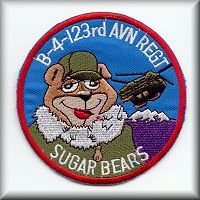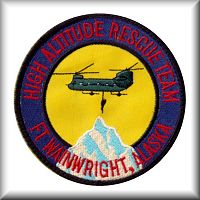 |
|
 |
| 90-00183 |
 |
|
 |
|
| 90-00183 on the ramp near Hangar 1 at Fort Wainwright, Alaska, 16 April 2003. |
| 90-00183, Boeing D model kit number M3335, was a CH-47D helicopter. The U.S. Army acceptance date was 30 November 1990, at 4,391.5 aircraft hours. The administrative strike date was 20 April 2004. As of 28 September 2001, 90-00183 had accumulated 1,640.8 D model hours and 6,027.8 total aircraft hours. 90-00183 was a conversion from the original C model Chinook 68-15816. On 21 December 1989, 90-00183 was inducted into the D model program, conversion complete on 15 November 1990, and initially assigned to the unit that would eventually become B Company - "Sugar Bears North", 4th Battalion, 123rd Aviation Regiment, located at Fort Wainwright, Alaska. Fort Wainwright was the former historic Ladd Field of World War Two era fame. B Company was the former C Company, 228th Aviation Regiment (16 October 1987 - 24 June 1994). 90-00183 was received by C Company on 18 January 1991. C Company was the former 242nd Assault Support Helicopter Company (ASHC) - "Muleskinners" (located in Alaska from November 1971 through 16 October 1987). When United States involvement in the Vietnam conflict ended, 242nd ASHC was re-located from the Republic of Vietnam (RVN) to Alaska. The aviation unit in Alaska at the time was designated the 236th ASHC, 19th Aviation Battalion (April 1971 - November 1971). When the 242nd ASHC re-located to Alaska and re-formed, the unit name changed from "Muleskinners" to "Sugar Bears" and the unit designation went from the 236th ASHC to the 242nd ASHC. At some point, the unit was split into two companies. One company remained in Alaska and became known as "Sugar Bears North". The other company, C Company, 1st Battalion, 228th Aviation Regiment, was relocated to Fort Kobbe, Panama and became known as "Sugar Bears South". 90-00183 remained assigned to the Sugar Bears until 20 April 2004, where it was lost due to an accident. While conducting Pathfinder insertion and extraction operations in the Yukon Training Area, approximately 25 miles east of Fort Wainwright, 90-00183 landed hard at Bravo Battery LZ (UTM Grid coordinate 6W WG12357105). The indications were the aircraft experienced a condition known as settling-with-power and then struck the ground very hard twice. The left aft landing gear struck first and the aircraft became airborne. Then the right aft landing gear struck and the aircraft became airborne. The double strike more than likely induced an out-of-balance condition in the rotor system similar to ground resonance. The aft pylon was torn from the airframe and the fuselage landed in an upright position. The cockpit section was partially torn loose from the main cabin section along the top portion and the bottom of the airframe, forward of the center cargo hook, was displaced upward. There were only minor injuries reported by the crew of four in the way of lower and upper back pain. There were no passengers aboard the aircraft. There was no post crash fire. Virtually every section of the airframe aft of STA 90 was damaged to some extent. The airframe was eventually classified as being damaged beyond economical repair - the cost of repair would exceed the purchase price of a new build helicopter (roughly $30 million dollars (2004)). Data from Historical Records. As of 20 April 2004, this aircraft was 35.53 years old. As of 20 April 2004, the last known location of 90-00183 was in Alaska. Aircraft status: Crashed. |
|
| A map showing the approximate location of the site where 90-00183 crashed. |
| The photographs below show 90-00183 at the crash site on or about 20 April 2004: |
| The Fuselage |
|
| At the termination of its final flight, 90-00183 sits on the western edge of the landing zone (LZ) Bravo Battery in the Yukon Training Area (YTA). The road leading off the the left side of the photograph is oriented 295 degrees magnetic. |
|
| The aft pylon was jettisoned during the crash sequence and placed off to the side. |
|
|
|
| Note the crack. This crack runs from the right forward landing gear, across the belly to the left forward landing gear, up to the top of the fuselage and over to the main cabin door, where it starts down towards the right forward landing gear. The crack almost completely separates the front portion of the fuselage from the aft portion. About the only thing holding the fuselage together at this point was some wiring, hydraulic lines, and the internal Robertson Extended Range Fuel System tank (ERFS II) that was squeezed between the cabin floor and the roof when the forward landing gear were displaced upward during the crash sequence. |
|
|
|
|
|
|
|
| Note the line in the snow leading to the right forward landing gear. It is evidence that the airframe slid left and forward after the final landing was made. |
|
|
|
|
| Believe it or not, when the aft pylon was jettisoned the forward rotor system didn't receive a single scratch, not even during the final landing event and rotor system coast down. |
|
| The Aft Pylon |
|
| A pretty amazing set-down for the aft pylon. Once jettisoned, the pylon just floated off to the side and gently set itself down in the snow. Even after the rotor blades contacted the ground, the pylon never moved (or even rotated) from the point of touchdown. The rotor blades simply coasted down and then beat themselves to a stop. All of the aft pylon mount and skin bolts were intact. |
|
|
|
|
| The photograph shows an aft blade dampener outboard lug damaged during the crash sequence. The Kevlar windings were broken by forces that exceeded design limits. |
| The Main Cabin |
|
| For the purposes of the airframe recovery, the cockpit and cabin sections were cargo strapped together to minimize any further damage. |
|
| A single ERFS II tank was installed. As the forward landing gear was shoved upward, the tank was squeezed between the cabin floor and roof. |
|
| The Station 534 bulkhead was compressed downward during the crash sequence. |
|
| The Move |
| The photographs below show 90-00183 in the process of moving from the crash site in the Yukon Training Area to Fort Wainwright for further examination and final disposition: |
|
| Above: A SCAMP is used to remove the forward rotor blades. Below, a HEMMT Wrecker vehicle's winch is used to prevent the airframe from rolling over on its side. Due to the damaged landing gear and airframe twist, there was a high probability that the aircraft would roll down the hill. Note the 4 foot ladder in the photo above. Until the wrecker was in-place, the ladder (wedged under the main cabin door handle) was the only thing preventing the aircraft from rolling on its side. |
|
|
|
| A 55 ton crane was moved into the site to lift the airframe onto a flat bed truck for transport back to Fort Wainwright. |
|
|
|
|
|
|
|
|
| The photographs below show 90-00183 after the move to Hangar 7 and 8 at Fort Wainwright: |
|
|
|
|
|
|
|
|
| Note the severed break-away fuel system fittings. No fuel was lost during the crash or post crash sequence even though most fittings were extensively damaged. On the day following the accident, some seepage was noted coming from the left main fuel tank forward brake-away fittings, but was more of an environmental rather than a crash safety issue. The above photograph also shows the right forward landing gear torque box displaced upwards approximately 6 to 12 inches as a result of the accident. |
| This aircraft was piloted by: |
| CPT Russell J. Elizondo, PI, 1995-1998. |
| CW2/3 Dennis Busch, PC, 1994-1997 - PC/MTP/ME, 1998-2001. |
| CW4 Mark S. Morgan, PC/MTP/ME, 2000-2003. |
| Your Name Here. |
| This aircraft was crewed by: |
| SSG Bert Lagasse, FE, 1996-1999. |
| SGT Rich Pittman, FE, 1999-2000. |
| SGT Joe Dillenburg, CE, 1999-2000. |
| SSG Ryan Galovics, FE, 2000-2003. |
| SSG Mike Ruffner, CE 2002-2004. |
| Your Name Here. |
| Related Sites |
| 87-00102 |
| A similar fate - 66-19110 |
 |
|
| Comments or Questions ? |  |
Email the Webmaster. |
|